the 2007 Abstract Presentations - Wound Healing Society
the 2007 Abstract Presentations - Wound Healing Society
the 2007 Abstract Presentations - Wound Healing Society
You also want an ePaper? Increase the reach of your titles
YUMPU automatically turns print PDFs into web optimized ePapers that Google loves.
<strong>Abstract</strong>s<br />
3<br />
FREEZING ALTERS THE VISCOELASTIC RESPONSE OF<br />
UNINJURED SKIN AND HEALING WOUNDS<br />
D.T. Corr 1,2 , C.L. Gallant-Behm 2 , N.G. Shrive 2 , D.A. Hart 2<br />
1 Biomedical Engineering, Rensselaer Polytechnic Institute, Troy, NY,<br />
2 The McCaig Centre, University of Calgary, Calgary, AB, Canada<br />
Aim: To determine if <strong>the</strong> practice of freezing skin, for storage and later testing,<br />
alters its viscoelastic behavior, and <strong>the</strong> influences of wounding and directionality<br />
on that behavior. We hypo<strong>the</strong>sized that freezing would change <strong>the</strong><br />
absolute material property values significantly, but would not change <strong>the</strong><br />
relative effect of specimen orientation or scarring.<br />
Methods: Tissue was harvested 70 days following full thickness wounding in<br />
juvenile female domestic pigs (N = 12). Skin sections were halved, one half<br />
tested fresh, and <strong>the</strong> o<strong>the</strong>rs frozen and stored at 80 1C for subsequent testing.<br />
Samples were obtained in <strong>the</strong> cranial-caudal and dorsal-ventral directions, for<br />
both scar tissue and uninjured skin, and were evaluated using in vitro stress<br />
relaxation in an INSTRON universal test machine. Frozen tissue was thawed<br />
slowly, and equilibrated to room temperature prior to testing. Specimens were<br />
kept moist throughout testing.<br />
Results: Frozen skin produced similar values to those of fresh skin in many<br />
instances. However, significant differences were observed in peak load, relaxation<br />
rate, and total relaxation (p o 0.05). Freezing appears to increase <strong>the</strong><br />
viscous response (faster, larger relaxation) of uninjured skin, without similarly<br />
affecting scars, indicating that tissue morphology may affect <strong>the</strong> retention of<br />
moisture with freezing/thawing. Moreover, <strong>the</strong> significant trends in <strong>the</strong>se<br />
properties observed in fresh specimens - with respect to specimen direction<br />
and scarring, were altered with freezing, yielding notably different directional<br />
and scarring trends. Thus, freezing produced changes in both <strong>the</strong> absolute<br />
values and relative response to specimen direction and scarring.<br />
Conclusions: Freezing skin samples does alter tissue viscoelastic properties,<br />
indicating that conclusions drawn from frozen skin and scar samples are not<br />
indicative of what may be observed with fresh skin.<br />
Acknowledgements: AIF, Ernst & Young, NSERC and CIHR.<br />
4<br />
A COMPARISON OF FUNCTIONAL CHARACTERISTICS OF<br />
CULTURED KERATINOCYTES FOLLOWING SEVERE BURN<br />
COMPARED TO NON-BURNED CONTROLS<br />
G.G. Gauglitz, M.G. Jeschke, G.Hv. Donnersmarck, E. Faist, D.N. Hernond,<br />
S. Zedler<br />
Introduction: Keratinocytes are not only important for structural support of<br />
<strong>the</strong> epidermis but also secrete biologically relevant growth factors that are an<br />
integral part of inflammatory response and immune function. The aim of <strong>the</strong><br />
present study was to determine whe<strong>the</strong>r cultured keratinocytes obtained from<br />
<strong>the</strong> proximity of a full thickness burn wound exert a different cytokine and<br />
growth factor expression profile compared to keratinocytes obtained from<br />
normal skin.<br />
Method: Seventeen non-burned patients and 17 severely burned patients<br />
(TBSA 4 25%) were included in <strong>the</strong> study. Immunohistochemistry was used<br />
to detect cytokeratin, vimentin and o<strong>the</strong>r proteins in order to allow comparison<br />
of cellular composition in allografts prepared from discarded tissue following<br />
breast reduction versus autologous cultured keratinocytes. Skin cells were<br />
cultured under standard conditions and in-vitro expression of mediators in <strong>the</strong><br />
culture media was quantified at 3, 10 and 15 days, using <strong>the</strong> Bioplex<br />
immunoassay (10 cytokines and 5 growth factors). Statistical analysis was<br />
performed by t-test with significance accepted at p o 0.05.<br />
Results: Leukocytes, macrophages, dendritic, endo<strong>the</strong>lial cells and fibroblasts<br />
could not be detected in ei<strong>the</strong>r autologous or in allogeneic transplants.<br />
Histological analysis revealed an increased proportion of terminal differentiated<br />
suprabasal cells in <strong>the</strong> allograft group compared to a higher proportion<br />
of proliferative basal cells in <strong>the</strong> autologous group. Both culture groups<br />
expressed large amounts of IL-1RA and IL-8 with no significant difference<br />
between <strong>the</strong> groups. IL-6 and GM-CSF were significantly increased in <strong>the</strong> burn<br />
group during <strong>the</strong> first 15 days of culture compared to controls (p o 0.05).<br />
Conclusion: Epidermal basal cells from burns show increased proliferative<br />
activity with increased mediator release. By skin grafting is a life-saving<br />
procedure.<br />
5<br />
WOUND COVERAGE WITH MICROBIAL NANOCELLULOSE<br />
IN TREATMENT OF DONOR SITE WOUNDS AND SKIN<br />
AUTOGRAFTS AFTER SEVERE BURNS<br />
Ludwik K. Branski 1 , Wojciech Czaja 2 , Marc G. Jeschke 1 ,<br />
William B. Norbury 1 , Oscar E. Masters 1 , Yoshimitsu Nakano 1 ,<br />
Daniel L. Taber 1 , R. Malcolm Brown 2 and David N. Herndon 1<br />
1 Shriners Hospital for Children and University of Texas Medical Branch,<br />
Galveston, Texas,<br />
2 University of Texas at Austin<br />
Introduction: In severely burned patients, early wound closure is essential and<br />
<strong>the</strong> choice of <strong>the</strong> correct dressing paramount. Microbial Nanocellulose (NC),<br />
an inert material produced by Acetobacter xylinum, has emerged as a new<br />
coverage material that is very conformable, can hold a large amount of liquid,<br />
and retains a high mechanical strength, <strong>the</strong>refore making it an ideal wound<br />
dressing. Our aim was to compare NC and standard dressing material in a<br />
porcine burn wound model.<br />
Materials and Methods: Third degree burn wounds (Treatment: n = 10, control:<br />
n = 8) were created using hot aluminum, excised 24 h post injury and<br />
grafted with autologous skin transplant (4:1 meshgraft, wound size: 50 cm 2 ).<br />
Donor sites (Treatment: n = 10, Control: n = 8) were created using an electric<br />
dermatome. Oil emulsion dressing (Adaptic s , Ethicon, Inc.) was used as<br />
control. Dressing changes were performed and standardized digital photographs<br />
taken at 2, 5, 9 and 14 days post injury. Re-epi<strong>the</strong>liazation, graft<br />
adherence, rate of infections, hematoma, fibrin deposition and rate of hypergranulation<br />
were assessed at each time point using a macroscopic grading scale.<br />
Results: In grafted wounds covered with NC, infections and hematoma occurred<br />
significantly less than in <strong>the</strong> controls at day 5 and 9 (p o 0.05). Graft adherence<br />
was significantly improved at day 9 (p o 0.003). Donor site wounds treated with<br />
NC showed significantly less fibrin deposition, hematoma, hypergranulation, and<br />
increased re-epi<strong>the</strong>liazation at day 9 (p o 0.04). 60% of <strong>the</strong> wounds in <strong>the</strong> NCgroup<br />
vs. 20% in <strong>the</strong> control group were completely healed at this timepoint.<br />
Conclusion: In a large animal trial, Microbial Nanocellulose accelerates wound<br />
healing and proves to be a safe and efficacious wound coverage material for<br />
donor sites and grafted wounds.<br />
6<br />
BISMUTH SUBGALLATE/BORNEAL (SUILE) VS.<br />
NANOCRYSTALLINE SILVER IN THE HUMAN FOREARM<br />
BIOPSY MODEL FOR ACUTE WOUND HEALING<br />
Thomas E. Serena, MD, FACS 1,2 , Laura K.S. Parnell 3 , Michelle Kauffman 1<br />
1 Gannon University,<br />
2 Penn North Centers for Advanced <strong>Wound</strong> Care, NewBridge Medical Research,<br />
3 Precision Consulting<br />
Background: The human forearm biopsy model has been employed to evaluate<br />
established and novel agents in acute wounds. Bismuth Subgallate/Borneol<br />
(Suile) is a new product with FDA permission for <strong>the</strong> treatment of partial<br />
thickness wounds. It was shown to be more effective than Bacitracin in an<br />
earlier forearm biopsy study. It has been suggested that its efficacy is due to its<br />
anti-inflammatory properties; although, it also has significant antimicrobial<br />
activity. This study focuses on its comparison to a commonly used antimicrobial<br />
dressing, Acticoat 3 TM (Smith and Nephew). Actcoat is a silver-coated<br />
high-density polyethylene mesh.<br />
Methods: In a randomized, investigator-blinded study, 40 normal healthy<br />
volunteers underwent two 6 mm full-thickness skin punch biopsies on <strong>the</strong> flexor<br />
surface of each forearm (two wounds/subject). Biopsies were randomly assigned<br />
to receive Suile or Acticoat 3. <strong>Wound</strong>s were examined, measured and<br />
photographed daily until healed. Adverse events were monitored. Time-tocomplete<br />
closure was determined.<br />
Results: Direct quantitative and qualitative comparisons of wound healing<br />
were observed. There was a trend toward more rapid healing in <strong>the</strong> Suile group<br />
particularly when <strong>the</strong> time to closure was examined on an individual basis:<br />
comparing <strong>the</strong> healing times between a subject’s two biopsies. The subjects<br />
reported more that <strong>the</strong> Suile dressing was more comfortable and demonstrated<br />
less skin discoloration.<br />
Conclusion: Suile has been shown to be an effective wound healing agent in <strong>the</strong><br />
forearm biopsy model. Based on <strong>the</strong> results of this and earlier studies its effect in<br />
this model appears to be due largely to its anti-inflammatory properties as<br />
opposed to its antimicrobial activity. Finally, <strong>the</strong> human forearm biopsy model<br />
has several advantages: direct comparison within subjects, rapid study completion,<br />
good patient compliance, and experience with products prior to embarking<br />
on larger clinical trials in wounds.<br />
Acknowledgement: Unrestricted Grant from Hedonist Biochemical Technologies.<br />
Co.<br />
<strong>Wound</strong> Rep Reg (<strong>2007</strong>) 15 A14–A54 c <strong>2007</strong> by <strong>the</strong> <strong>Wound</strong> <strong>Healing</strong> <strong>Society</strong><br />
A15




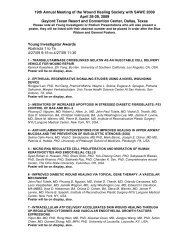

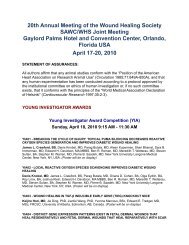
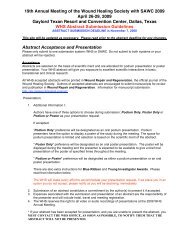
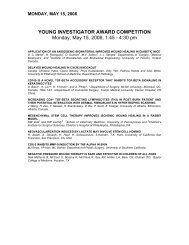



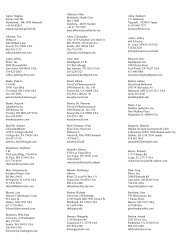
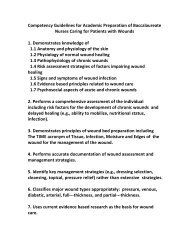
![2010 Abstracts-pah[2] - Wound Healing Society](https://img.yumpu.com/3748463/1/190x245/2010-abstracts-pah2-wound-healing-society.jpg?quality=85)